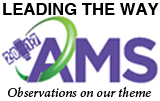Every journey begins somewhere—sometimes all you need to do is start heading down a path.
 This year AMS Past-President Fed Carr has given our Annual Meeting a destination: a comprehensive consideration of our observing needs. He’s also given us a place to embark on our journey: the Presidential Forum this morning (9 AM, Ballroom 6ABC) in which moderator Vanda Grubišić and her distinguished panel take us on a guided tour of our community’s capabilities and a glimpse of the multidisciplinary realms just beyond our reach.
This year AMS Past-President Fed Carr has given our Annual Meeting a destination: a comprehensive consideration of our observing needs. He’s also given us a place to embark on our journey: the Presidential Forum this morning (9 AM, Ballroom 6ABC) in which moderator Vanda Grubišić and her distinguished panel take us on a guided tour of our community’s capabilities and a glimpse of the multidisciplinary realms just beyond our reach.
He’s given us everything but the actual path. That choice is yours.
One option that beckons right from the Forum is the path of innovative platforms and systems that continually expand the ways we observe. It’s a path that travels across land, through air and water. It requires vehicles of all kinds and sizes, and takes your quest through every byway of modeling, theory, services, products, and yes, even observations, in search of our observational needs for the future .
Let’s look at a few of the milestones along the path of alternative observing, if you choose to take it.
Roadways themselves are paths, of course, and the Annual Meeting will showcase the new ways roads are a vital part of observing. On Tuesday (9:15 AM), Jeremy Paul Duensing of Schneider Electric will examine the success of Alberta Transportation’s road weather sensor network. One of the largest intelligent road observing systems in North America, this network features sensors taking 100 readings per second directly on vehicles.
Also on Tuesday, at 9:30 AM, Amanda Anderson of NCAR will review the Wyoming Department of Transportation’s project to collect weather (and other) data from internet-connected vehicles traveling on the state’s portion of I-80, which is prone to all sorts of hazardous conditions from blizzards to wildfires.
Meanwhile, the Oklahoma DOT combines a roadside weather information system with modeling and GIS visualization software to monitor road icing hazards. Benjamin Toms of the University of Oklahoma will discuss this system on Tuesday at 11:15 AM.
Our emerging technologies pathway extends skyward, too. On Wednesday at 9:45 AM, learn more from Djamal Khelif of the University of California, Irvine, about the Controlled Towed Vehicle (CTV), which utilizes improved towed-drone technology to measure spatial and temporal variability of sea surface temperatures, wind, temperature, and humidity, as well as turbulent air-sea fluxes from observations made as low as eight meters.
Range into space as well—you no longer need big, complicated satellites to get there. On Wednesday at 8:45 AM, as William Blackwell of MIT Lincoln Laboratory explores the capabilities of CubeSats in microwave high-resolution atmospheric remote sensing. James Clemmons of The Aerospace Corporation will investigate the potential uses of CubeSats in space weather research on Monday at 4:30 PM .
The path even extends onto and into the water. On Monday at 4 PM, Maricarmen Guerra Paris of the University of Washington will review a project that utilizes ferries equipped with Acoustic Doppler Current Profilers to provide full-depth profiles of currents and distinguish tidal currents adjacent to Puget Sound.
The Annual Meeting is full of such unconventional paths—paths of invention paving the way to observation. It’s time to make the choice and your journey.